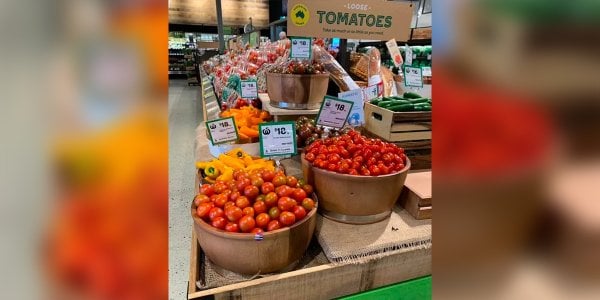Another price surge? Find out how El Niño may cause skyrocketing costs for fruits and vegetables at your local supermarket
By
VanessaC
- Replies 32
Fruits and vegetables may soon be costing us more at the checkout as the nation braces for very warm and dry seasons due to El Niño.
The Bureau of Meteorology has also issued a warning to prepare for a warmer weather pattern, with the possibility of bushfires and drought happening.
Drier-than-normal conditions could cause a great deal of strain on crop yields, potentially inflating the price of fresh produce—just like what happened last year due to La Niña conditions.
This El Niño event has already caused an increase in temperatures thanks to a warmer winter, giving fruit and vegetable growers a strong growing flush with lettuce, which is now priced at as low as $2.
One vegetable grower from Victoria, Catherine Velisha, said: 'We're in a real growing flush - this is for most products, both fruit and veg.'
'This has been our first year in quite a long time that we've had so much available stock, with absolutely no disruptions.'
Shoppers are also reportedly getting the best value for their money with the cheap prices.
'On average, prices are about 40 per cent less than they were last year across the board for vegetables, which is huge,' Ms Velisha added.
At Woolworths, shoppers are able to pick up broccoli for just 99 cents each and red capsicums for $1.23, with some produce pricing slashed by more than half.
Woolworths General Manager of Fruit & Vegetable, Paul Turner, said that prices, compared to this time last year, have reduced significantly.
'Last year, customers saw inflated prices on fruit and [vegetable] driven by short supply as a result of flooding and cool growing conditions, particularly in our [vegetable] categories,' Mr Turner said.
'The good news this year is that favourable growing conditions are returning us to an abundant supply of [vegetable], which means some great in-season value for customers.'
However, as El Niño is well on its way, consumers are encouraged to make the most of the current low prices on their groceries, especially on their fruit and vegetables, while they still can as these prices are not guaranteed to last.
The drier and warmer winter has also negatively affected some essential crops, wiping an estimated $12 billion off the cost of agricultural production this financial year.
Furthermore, according to the forecasts of the Department of Agriculture, production of wheat is expected to drop by 36 per cent this season and canola yields by 38 per cent, therefore affecting some supermarket shelf staples.
Many are feeling the pinch of the cost of living crisis, especially those struggling to afford basic supplies.
One Aussie posted a video to social media where he was shocked at how much his tiny haul of groceries cost at Coles—a whopping $91.84 despite purchasing a home brand or products on sale at Coles.
'Can someone please explain to me why Australia has gone down the absolute toilet? Because the cost of living at the moment is a joke,' he said.
'I'm making one meal tonight, fried rice, and we got the dog some food, OK? This came to $91,' he shared, showing the viewers the items he got.
He ended the video outraged, saying: 'I don't understand.'
You can read more on this story here.
Meanwhile, amid all the news of endless increases in grocery prices at the supermarket, many have started exploring other options, and savvy shoppers have turned to their local independent grocers for cheaper produce.
One Queensland shopper visited their local grocer and stumbled upon an amazing $6 deal on their fruits and vegetables.
You can also read more about this here.
 Members, have you been feeling the pinch in your pockets too? What are some of your tips on stretching your budget further for groceries? Share them with us in the comments below!
Members, have you been feeling the pinch in your pockets too? What are some of your tips on stretching your budget further for groceries? Share them with us in the comments below!
The Bureau of Meteorology has also issued a warning to prepare for a warmer weather pattern, with the possibility of bushfires and drought happening.
Drier-than-normal conditions could cause a great deal of strain on crop yields, potentially inflating the price of fresh produce—just like what happened last year due to La Niña conditions.
This El Niño event has already caused an increase in temperatures thanks to a warmer winter, giving fruit and vegetable growers a strong growing flush with lettuce, which is now priced at as low as $2.
One vegetable grower from Victoria, Catherine Velisha, said: 'We're in a real growing flush - this is for most products, both fruit and veg.'
'This has been our first year in quite a long time that we've had so much available stock, with absolutely no disruptions.'
Shoppers are also reportedly getting the best value for their money with the cheap prices.
'On average, prices are about 40 per cent less than they were last year across the board for vegetables, which is huge,' Ms Velisha added.
At Woolworths, shoppers are able to pick up broccoli for just 99 cents each and red capsicums for $1.23, with some produce pricing slashed by more than half.
Woolworths General Manager of Fruit & Vegetable, Paul Turner, said that prices, compared to this time last year, have reduced significantly.
'Last year, customers saw inflated prices on fruit and [vegetable] driven by short supply as a result of flooding and cool growing conditions, particularly in our [vegetable] categories,' Mr Turner said.
'The good news this year is that favourable growing conditions are returning us to an abundant supply of [vegetable], which means some great in-season value for customers.'
However, as El Niño is well on its way, consumers are encouraged to make the most of the current low prices on their groceries, especially on their fruit and vegetables, while they still can as these prices are not guaranteed to last.
The drier and warmer winter has also negatively affected some essential crops, wiping an estimated $12 billion off the cost of agricultural production this financial year.
Furthermore, according to the forecasts of the Department of Agriculture, production of wheat is expected to drop by 36 per cent this season and canola yields by 38 per cent, therefore affecting some supermarket shelf staples.
Many are feeling the pinch of the cost of living crisis, especially those struggling to afford basic supplies.
One Aussie posted a video to social media where he was shocked at how much his tiny haul of groceries cost at Coles—a whopping $91.84 despite purchasing a home brand or products on sale at Coles.
'Can someone please explain to me why Australia has gone down the absolute toilet? Because the cost of living at the moment is a joke,' he said.
'I'm making one meal tonight, fried rice, and we got the dog some food, OK? This came to $91,' he shared, showing the viewers the items he got.
He ended the video outraged, saying: 'I don't understand.'
You can read more on this story here.
Meanwhile, amid all the news of endless increases in grocery prices at the supermarket, many have started exploring other options, and savvy shoppers have turned to their local independent grocers for cheaper produce.
One Queensland shopper visited their local grocer and stumbled upon an amazing $6 deal on their fruits and vegetables.
You can also read more about this here.
Key Takeaways
- Australians may soon face increased prices for fruit and vegetables due to the anticipated El Niño weather pattern, which can cause hotter and drier conditions, leading to poor crop yields.
- This increase comes after a drop in prices this year due to a warmer winter, with vegetable prices about 40 per cent less than the previous year.
- The rising cost of essential groceries, with produce prices expected to rise, adds another strain for Australians already dealing with a cost-of-living crisis.
- The drought and warming conditions aren't just affecting fresh produce but are also predicted to negatively impact wheat and canola yields, thus affecting a range of supermarket items.








